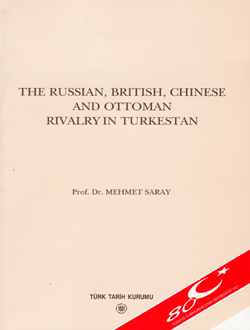|
ACKNOWLEDGEMENTS
|
|
I - INTRODUCTION
|
|
II – THE RUSSIAN EXPANSION IN TURKESTAN AND CENTRAL ASIA
|
|
1) The Beginning of Russia’s Southeast Expansion
|
|
2) Bariatinskii's Influence
|
|
3) Russia Advances and Occupies Khokand
|
|
4) Dealing with Bukhara
|
|
5) Appeals to Britain and Turkey
|
|
6) Capitulation and Consolidation
|
|
7) Russia’ s Expansion Continued: Occupation of Khiva
|
|
8) Russia’ s Establishment of the Trans-Caspian Military District in 1874 and Her Advance in Turkmenistan
|
|
9) The Russian Invasion of Turkmenistan
|
|
10) Conclusion
|
|
III- BRITISH POLICY IN CENTRAL ASIA
|
|
1) Britain Alarmed by Russia's Expansion in the Caucasus
|
|
2) Britain Defends Herat Against Russo-Persian Alliance
|
|
3) The First British Invasion of Afghanistan
|
|
4) Russia’s Occupation of Turkestan Forced Britain to Form an Alliance with Afghanistan
|
|
5) The British Reaction to the Russian Advance in Turkmenistan
|
|
6) Britain's Second Invasion of Afghanistan
|
|
7) The End of the British-Russian Rivalry in Central Asia
|
|
8) Conclusion
|
|
IV - THE CHINESE EXPANSION IN EASTERN TURKESTAN
|
|
1) Eastern Turkestan: Historical Background
|
|
2) Khokand's Influence in Eastern Turkestan
|
|
3) The Rise of Yakub Khan and the Foundation of Independent East Turkestani State (or Amirade of Kashghar)
|
|
4) The British, Russian and Ottoman Interest in Eastern Turkestan
|
|
a) The British Interest in Eastern Turkestan
|
|
b) The Russian Interest in Eastern Turkestan
|
|
c) The Ottoman Interest in Eastern Turkestan
|
|
5) China's Expansionist Policy in Central Asia
|
|
6) General Tso Tsung -t'ang and Invasion of Eastern Turkestan
|
|
7) The sudden Dead of Yakub Khan and the Collapse of Kashghar Amirate
|
|
8) Conclusion
|
|
V - OTTOMAN POLICY IN TURKESTAN
|
|
1) The Earliest Phase of Turkish History
|
|
2) The Emigration of the Oghuz from Turkestan to the Middle East
|
|
3) The Rise of the Uzbek Khanates in Turkestan
|
|
4) The Ottoman Policy Toward the Uzbek Khanates
|
|
5) Russia's Expension to the Southeast Creates Anxiety Among the Ottomans and Uzbek Khanates
|
|
6) The Ottoman Empire and Eastern Turkestan
|
|
7) Conclusion
|
|
VI - APPENDIX
|
|
VII - BIBLIOGRAPHY
|
|
VIII – INDEX
|

